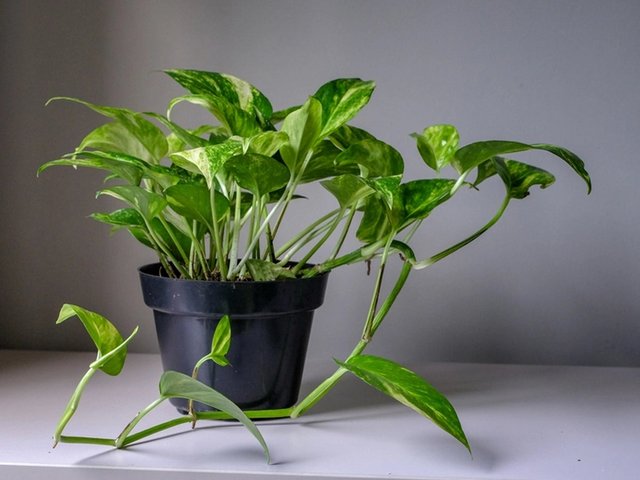Money plant

The money plant, also known as Epipremnum aureum, is a popular houseplant admired for its hardiness and attractive foliage. It belongs to the Araceae family and is native to the Solomon Islands. Commonly known by various names such as golden pothos, devil's ivy, and hunter's robe, the money plant is cherished for its ability to thrive in a variety of indoor conditions and its low maintenance requirements.
Characteristics
Leaves and Growth: The money plant has heart-shaped, glossy leaves that are usually green with yellow or white variegation. The plant can grow both in soil and water, making it versatile for different types of indoor environments. It is a vine, so it can trail or climb, often requiring support like a moss stick or trellis for vertical growth.
Size: In its natural habitat, the money plant can grow up to 40 feet tall. However, as an indoor plant, it typically reaches around 6-10 feet, depending on the conditions and care provided.
Care Requirements
Light: Money plants prefer bright, indirect light but can also tolerate low light conditions, making them suitable for various indoor spaces, including offices and homes with limited sunlight.

Water: The plant requires moderate watering. It's best to let the top layer of soil dry out between waterings to avoid root rot. When grown in water, changing the water every 2-3 weeks and keeping the container clean is essential to prevent bacterial growth.
Temperature and Humidity: Money plants thrive in temperatures between 65-85°F (18-29°C). They prefer moderate to high humidity levels, which can be maintained by occasional misting or using a humidifier.
Soil: A well-draining potting mix is ideal for money plants. Adding perlite or sand can improve drainage.
Fertilization: Fertilizing every 4-6 weeks during the growing season (spring and summer) with a balanced, water-soluble fertilizer can promote healthy growth. Fertilization can be reduced or stopped during the fall and winter months.
Benefits
Air Purification: Money plants are known for their air-purifying qualities. They can remove common indoor pollutants such as formaldehyde, xylene, and benzene, improving indoor air quality.
Aesthetic Appeal: With their lush, trailing vines and attractive foliage, money plants add a touch of nature and beauty to indoor spaces. They can be used in hanging baskets, on shelves, or as part of a green wall.
Cultural Significance: In many cultures, the money plant is believed to bring good luck, prosperity, and positive energy, often given as a gift during housewarming or business openings.
Propagation
Money plants are easy to propagate through stem cuttings. A healthy vine cutting placed in water or directly in soil will develop roots within a few weeks. This makes it easy to expand your collection or share with friends and family.
Common Problems
Pests: Money plants are relatively pest-resistant but can occasionally be affected by spider mites, mealybugs, and aphids. Regularly inspecting the plant and wiping the leaves can help prevent infestations.
Yellowing Leaves: This can be a sign of overwatering, poor drainage, or insufficient light. Adjusting care routines usually resolves the issue.
Leggy Growth: If the plant becomes leggy with sparse leaves, it may not be receiving enough light. Moving it to a brighter location can encourage fuller growth.
The money plant is a versatile and easy-to-care-for houseplant that not only enhances the aesthetic appeal of indoor spaces but also contributes to a healthier living environment. Its resilience and air-purifying properties make it a favorite among both novice and experienced plant enthusiasts.
Congratulations, your post has been upvoted by @upex with a 0.33% upvote. We invite you to continue producing quality content and join our Discord community here. Keep up the good work! #upex